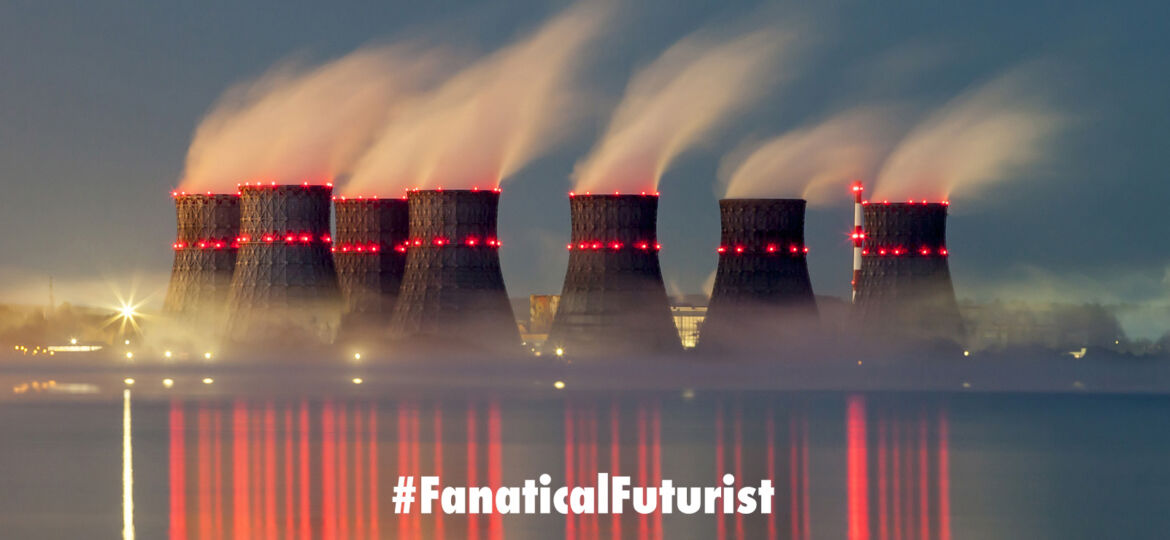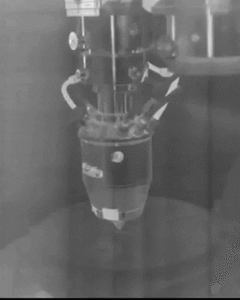
WHY THIS MATTERS IN BRIEF
The way we make nuclear reactors hasn’t really changed in decades, but now 3D printed nuclear reactors made in labs are on the verge of changing everything.
 Interested in the Exponential Future? Connect, download a free E-Book, watch a keynote, or browse my blog.
Interested in the Exponential Future? Connect, download a free E-Book, watch a keynote, or browse my blog.
Recent technology developments means we can now 3D print and 4D print everything from buildings, cars, clothes, corals, explosives, rocket engines, and satellites, to brain tumors, human body parts and skin, and even beef in space! All of which, I think you’ll agree are amazing. But what if you could 3D print your very own nuclear reactor in the comfort of your own home or top secret basement?
Recently I talked about how in 2021 Rolls Royce are going to be building the world’s first mini truck sized nuclear reactors, and now Wekurt Terrani at Oak Ridge National Lab in the US wants to accelerate the future of nuclear energy again, so he’s turned to its past.
Over the last year and a half Terrani and a team of physicists, engineers, and computer scientists have designed and built the components for a gas-cooled nuclear reactor. It’s a type of reactor that’s almost as old as the nuclear age itself, but Oak Ridge’s newest atom splitter has a distinctive 21st Century twist. When it comes online in 2023, it will be the first nuclear reactor in the world with a 3D printed nuclear core.
“What we’re doing is trying to figure out a faster way to build a nuclear system that has superior performance,” says Terrani, who is the technical director for the Oak Ridge Transformational Challenge Reactor program. “The goal is to fundamentally change the way we do nuclear.”
The nuclear industry has a reputation for being incredibly conservative and resistant to change, and Terrani laments that all of America’s nuclear reactors are still using technology that was dreamed up a half-century ago. The “if it ain’t broke, don’t fix it” mindset is a way to manage the inherent risk and exorbitant cost of building new nuclear plants, but it’s also stifled innovation in an industry that supplies the vast majority of America’s carbon-free energy. Terrani’s worry is that if the nuclear industry doesn’t embrace new technology, it will soon be obsolete.
This isn’t to say we should start building experimental nuclear plants without due diligence. The reason the nuclear industry moves so slowly is that the price of a miscalculation is huge – the accidents at Chernobyl and Fukushima were generation-defining disasters that no one wants to repeat. But risk aversion hasn’t stopped other notoriously stuffy industries from embracing new technologies. Just look at aerospace, where companies now 3D print entire rockets, fly autonomous planes, and catch reusable boosters on drone ships. And anyway, most of the advanced reactors under development today aren’t entirely new, they’re modified designs of reactors that were successfully built decades ago.
“We know all these concepts work,” says Terrani. “The problem is we can’t build them fast and cheap enough.”
Terrani and his colleagues are working on this problem. The Oak Ridge team recently finalized the preliminary design for the 3D printed core at the heart of its Transformational Challenge Reactor, or TCR. Although most of the reactor will be made from conventional components, the core will be entirely 3D printed out of silicon carbide, an extremely rugged material that is all but impossible to melt. The cylindrical core is a dull metallic silver with several irregular nonagon fuel assemblies arranged in its center.
This is where all the magic happens in a nuclear reactor – it’s responsible for holding the uranium fuel and the components that control the fission reaction. The core designed and printed at Oak Ridge is less than a foot-and-a-half tall and will be housed in a reactor that isn’t much bigger than a beer keg. But when it comes online in 2023, Terrani says it will generate up to 3 megawatts of power, enough to meet the energy needs of more than 1,000 average homes.
The TCR is an advanced gas-cooled reactor that uses helium as coolant, whereas most operational reactors in the US today use water. Gas-cooled reactors are extremely fuel efficient because they operate at very high temperatures, this one will run at around 1,200 degrees Fahrenheit, and Terrani says that 3D printing the reactor core will boost the efficiency even higher. Moreover, traditional machining techniques for building a reactor core constrain their design. The complex network of cooling channels in the Oak Ridge core are too small and tortuous for any conventional machining techniques. But since 3D printers build an object by fusing metal together layer by layer, engineers can build previously impossible core designs.
“We’re no longer stuck with boring geometries,” Terrani says. “Instead of an array of things that all look the same, you can change the design across the core and get your system to respond to the environment.”
3D printing will also help nuclear engineers get a better picture of what is happening inside a core once the reactor is up and running. In a conventional reactor, a core’s behavior has to be monitored from the outside. But the new designs enabled by 3D printing will allow for embedded sensors that will provide data directly from the core. Furthermore, 3D printing also gives nuclear engineers more control over the manufacturing process. Individual parts of the TCR core take anywhere from 8 to 24 hours to print and Terrani says the entire core can be printed in a few weeks. During a print, a machine vision algorithm is sucking in data from infrared cameras and other sensors that help it determine if any defects occur during printing.
But it’s what comes next that Terrani sees as the biggest game changer. When a part is made for a conventional nuclear reactor, it has to go through an expensive and slow certification process. How expensive? Terrani says he knows of a nuclear plant that had to pay $20,000 for a bolt at that cost just a few cents to make because the bolt was specially certified for nuclear systems.
“One of the most expensive and time-consuming steps for a new structural component in a nuclear reactor core is the cost to qualify the component,” says Nicholas Brown, a nuclear engineer at the University of Tennessee, Knoxville. “Typically, this process can take decades and millions or billions of dollars.”
Brown says that the costs of new parts run so high because certifying them typically involves a “cook and look” process: a new part is put in a test reactor to see how it performs, engineers make changes to the part based on this data, and the process is repeated until the performance meets expectations. Like the nuclear reactor technologies themselves, the process of qualifying them for use is stuck in the 1970s.
Terrani hopes that the reams of data generated by 3D printing parts can speed up the certification process and lower the cost of getting a nuclear reactor online. He says that a 3D printed widget the size of your hand could easily generate hundreds of gigabytes of information about the quality of the part. If there’s a defect, it will show up in the data – there’s no need to use ultrasound and other expensive tests to look for it. But instead of having a human sift through the mountain of data generated by the 3D printer, researchers at Oak Ridge are training a machine learning algorithm to use that data to verify parts.
“Once we make the stuff, we don’t have to come back and spend multiple months certifying things,” Terrani says. “Imagine the moment that you’re done making a part and the AI can tell you if it’s good or bad. That’s the dream.”
The TCR’s gas-cooling system is fundamentally a souped up version of the X-10, the world’s first nuclear reactor designed for continuous operation. Built at Oak Ridge in the early 1940s, the X-10 was turned on for the first time only 9 months after construction started. It’s an astounding pace, given that the only nuclear reactor under construction in the US today is expected to take at least 12 years to finish. Terrani hopes that 3D printing, AI, and other new exponential technologies can bring this rapid pace of development and deployment back to the nuclear industry.
“Nuclear power can’t be the only industry that doesn’t adopt any new technologies,” he says. “We want to open the floodgates and see advanced nuclear power in this country.”




















[…] mix. As such the number of breakhroughs in the sector are booming whether it’s in the form of 3D printable nuclear reactors, Thorium reactors, floating nuclear reactors, or even mini […]